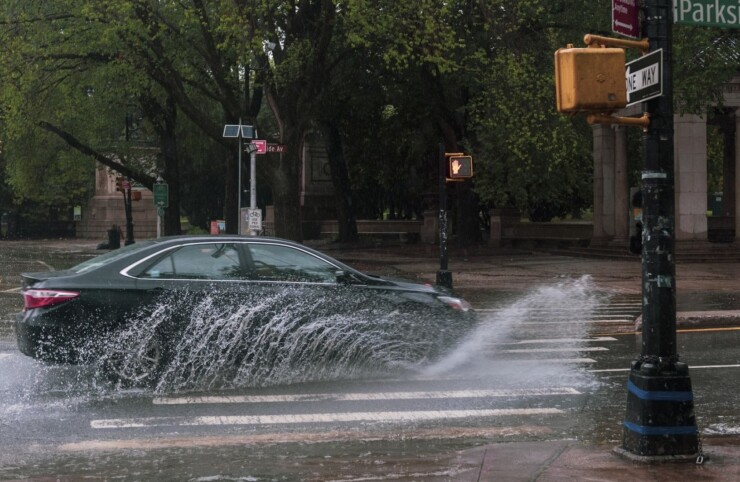Tropical Storm Henri’s drenching of several Northeast regions exposed vulnerabilities that vary by state.
The scenarios are familiar, and expect to repeat over the next couple of months, according to climate resilience expert Alan Rubin. And that could jeopardize state and city credit.
“There’s a problem here,” said Rubin, a principal at Blank Rome Government Relations LLC and co-head of its severe weather emergency recovery team.
Rubin said issuers should follow BRIC, or Building Resilient Infrastructure and Communities principles that the Federal Emergency Management Agency has established to help reduce risks from disasters and hazards.
“If they’re not doing that, they’re going to have major problems with their credit ratings,” he said.
Bond rating agencies are increasingly factoring climate resilience into their environmental, social and governance, or
The National Federation of Municipal Analysts released a
The Government Finance Officers Association in March

Regardless of disclosing threats, weather events from
While weather officials downgraded Henri from a hurricane, New Jersey experienced widespread flooding around Middlesex County. In the New York City region, drainage problems contributed to up to nine inches of rain in Brooklyn on Sunday.
Connecticut, home to leafy suburbs, had lingering ground moisture from Hurricane Fred that harsh inland rainfall amplified.
A tornado touched down in Boston’s western suburbs on Monday as remnants of the storm circled back.
Rhode Island, the nation’s smallest state with a 40-mile by 60-mile land mass, has excessive coastal exposure.
The Northeast, while not typically subject to the size and frequency of storms in the south, has much older
City and state officials spent Monday still in triage mode, assessing both damage and costs. President Biden over the week made disaster declarations for New York, Connecticut and Rhode Island, and added Vermont on Monday, making those states available for relief through the Federal Emergency Management Agency.
“We need that federal money to be able to do some of the more structural kind of ongoing work that we need to do,” New York Mayor Bill de Blasio told reporters. “Everything you delineated, it's going to be changed profoundly by the kind of infrastructure plan that we see coming out of the Congress.”
New York and other places with older infrastructure intend to be “super competitive” in pursuing grants, de Blasio added.
“New York City has a great batting average in terms of winning these federal grants when they're competitive. So, yeah, this is the kind of thing that actually will allow us to get at these foundational problems and address the flooding in particular.”
The CARES Act federal rescue plan that Congress passed in March 2020 provides an additional $45 billion to FEMA’s disaster relief fund, more than doubling the amount available to support presidential emergency and disaster declarations.
“There’s plenty of money in the system,” Rubin said.
Lessons from the past, notably Hurricane Sandy in October 2012, still don’t resonate enough, according to Rubin. The megastorm inflicted an estimated
“What jumps out at me in New York City is that we still face the kinds of issues we had with Hurricane Sandy, and that was almost 10 years ago,” Rubin said.
“Flooding is still a major problem. We saw eight inches of rain so storms are still problematic. Within 48 hours of a storm, you should clean all your storm drainage.”
City emergency management commissioner John Scrivani acknowledged the challenge in a television interview.
“Sometimes it’s a constant battle,” he said.
FEMA revised its flood maps in 2018.
“Plans are great, but not if they sit on the shelves,” Rubin said. For New York City in particular, its outer boroughs need special attention because of their quirky topography.
The aftermath could also involve second-guessing of utility providers including Consolidated Edison Inc. in New York City and Eversource, which covers most of Connecticut, and possible oversight hearings by lawmakers.
New York City Public Advocate Jumaane Williams — reportedly on the short list for a lieutenant governor nomination now that Kathy Hochul is in office — last year called for a
Problems with Eversource last year prompted Gov. Ned Lamont’s administration to consider a performance-based contracting system.





